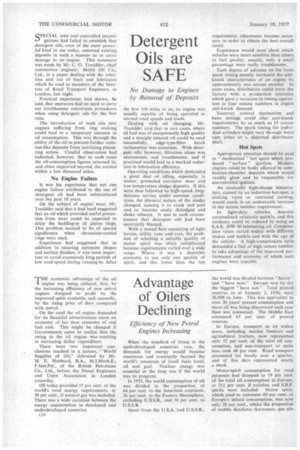• Advantage of Oilers Declining
Page 56

Page 59

If you've noticed an error in this article please click here to report it so we can fix it.
Efficiency of New Petrol Engines Increasing
THE economic -advantage of the oil engine was being reduced, first, by the increasing efficiency of new petrol engines designed to profit by the improved spirit available, and, secondly, by the rising price of dervcompared with petrol.
On the road the oil engine depended for its financial attractiveness more on economy of tax than economy of real fuel cost. This might be changed if Governments came to realize that the swing to the oil engine was resulting in increasing dollar expenditure.
These were two important. conclusions reached in a lecture, "World Supplies of Oil," delivered by Mr. M. E. Hubbard, B.A., M.I.Mech.E., F.Inst.Pet., of the British Petroleum Co., Ltd., before the Diesel Engineers and Users Association in London yesterday.
Oil today provided 37 per cent, of the world's total energy requirements, or 50 per cent., if natural gas was included. There was a wide variation between the energy consumption in developed and underdeveloped countries.
cl 6
When the standard of living in the underdeveloped countries rose, the demands for energy would become enormous and eventually beyond the world's resources of fossil fuels (coal, oil and gas). Nuclear energy was essential in the long run if the world was to progress.
In 1955, the world consumption of oil was • divided in the proportion of 64 per cent, to the American continent, 26 per cent. to the Eastern Hemisphere, excluding U.S.S.R., and 10 per cent, to U.S.S.R.
Apart from the U.S.A. and U.S.S.R.,
the world was divided between " haves " and "have nots." Europe was by far the biggest "have not," Total proved reserves as at January 1, 1956, were 26,000 m. tons. This was equivalent to over 30 years' present consumption and more oil was being discovered each year than was consumed. The Middle East contained 65 per cent, of proved reserves.
In Europe, transport in its widest sense, including marine bunkers and agricultural tractors, now represented only 52 per "cent, of the total oil consumption, and non-transport or static uses took 48 per cent. Road transport accounted for barely over a quarter, and of this dery represented nearly a third.
Motor-spirit consumption for road purposes had dropped to 19 per cent. of the total oil consumption in Europe, or 211 per cent, if aviation and S.B.P. spirits were included. Motor spirit, which used to represent 49 per cent. of Europe's inland consumption, was now only 28 per cent., whilst the proportion of middle distillates (kerosenes, gas oils
and derv) had risen from 17 per cent. to 27 per cent.
Though there was a margin of refining capacity in Europe; and ample Middle East (low dollar content) crude oil available, it was not possible in 1955 to match product output with demand because of the limited consumption of motor spirit.
Whilst nearly 500,000 tons of motor spirit had been exported (all that the rest of the world would take), it was necessary to import 4m. tons of middle distillates (mainly oil Net) and 21m. tons of fuel oil, nearly all from dollar areas. This disequilibrium resulted mainly from the swing from the petrol to the oil engine on the road.
An oil-engined vehicle, consuming
about two-thirds of the gallonage of its petrol equivalent, saved roughly a third of the real fuel cost, plus an equal proportion of tax when, as in the U.K.. both fuels carried the same tax per gallon. In most other countries, however, the tax on dery was at a lower rate than that on petrol, so-that the tax saving was even greater.
For example, in the case of aAypical heavy truck operating in the U.K., if the saving in the fuel bill to the operator was £247 per year, only £97 was due to the fuel itself and £150 to the lower aggregate tax. In Denmark the fuel saving for the same vehicle would be £545, of which the tax element would be £438.
Oil-engined vehicles now in use in Europe were benefiting, as compared with the equivalent petrol vehicles, by a tax differential of the order of £200m. per year.
Motor-spirit prices had remained roughly constant in a world of rising prices. Gas/Diesel oil and fuel oil had risen steadily in price until today the f.o.b. price of dery was actually higher than that of regular-grade motor spirit.
The main problem for the oil industry, if present trends continued, would be to produce sufficient derv. To ensure maximum supplies, specifications for oil fuel should be as wide as possible, because any restriction reacted on availability. The oil engine, ili it wanted to be sure of an adequate food supply, must be omnivorous.








































































































